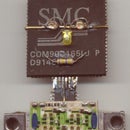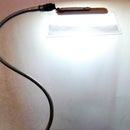Introduction: Wiring Pen
Attach a spool of wire and a hypodermic needle to a ball point pen barrel to make an aid to make point-to-point wiring easier to do. The board shown is a microprocessor system board with a 8085, 2764 and 6464 - that is, the CPU, EPROM and RAM - and some additional glue circuitry.
Step 1: The Parts
A hypodermic needle. Get the disposable type with a plastic collar, as this will need to be cut down to make it fit in the nozzle of the ball point pen.
A (used) ball point pen. I acquired one with a metal nozzle as it would probably last longer.
The spool of enamelled wire was from a relay, 12 V changeover contacts - the rest of the relay was dismantled with care not to damage the spool of wire. Other sources are transformers and rf chokes.
Some two component epoxy to cement the needle to the nozzle.
A screw long enough to hold the spool of wire (not shown)
Step 2: Putting It All Together
First, some copper wire was placed inside the needle to prevent its bore from closing up, and its sharp point was ground square on some fine emery paper.
Its plastic collar was cut to make it fit inside the nozzle of the ball pen, and it was fixed in position using some two component epoxy glue.
The screw was heated and poked into the side of the pen, and on cooling it was unscrewed. The spool of wire was placed on to it, and it screwed back on. The wire was led through the body of the pen and out through the needle tip.
The thin tip of the wiring pen enables it to be used to snake the wire through tight spots, and to make connections to tightly packed integrated circuit socket pins.
To make a connection, the (enamelled) wire is wrapped once or twice round the ic or socket or component pin. Heating the joint, and applying some solder will complete the joint - if you are lucky enough to find some 'self fluxing' enamelled wire. This sort of wire is coated with the sort of enamel that changes to flux when heated to soldering temperature.
I prefer to use normal, tough enamelled wire, as the chances for accidental short circuits is reduced while using this type of wire. The joint has to be heated and then the enamel can easily be scraped off using a sharp edge of a small jewelers screwdriver. Then solder is applied and the solder will attach to the freshly exposed copper.
I used to make all my prototypes this way, until the coming of the flash microcontrollers with on chip program and data memory, which does not need this scale of wiring in order to work.













